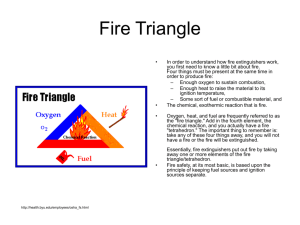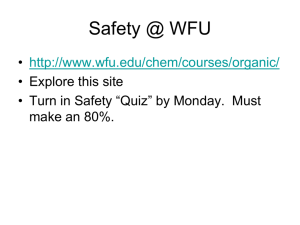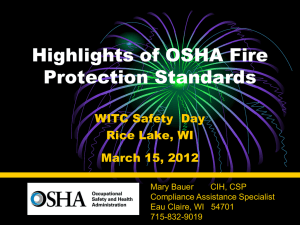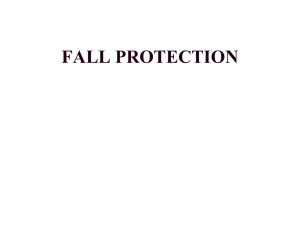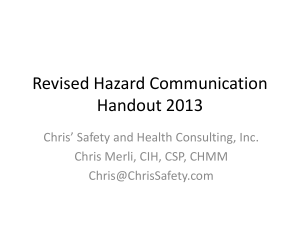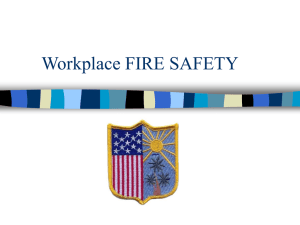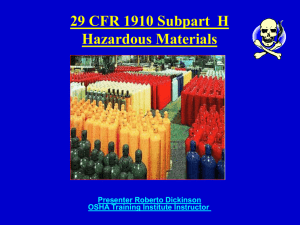NFPA 80A Recommended Practice for the Protection of Buildings
advertisement
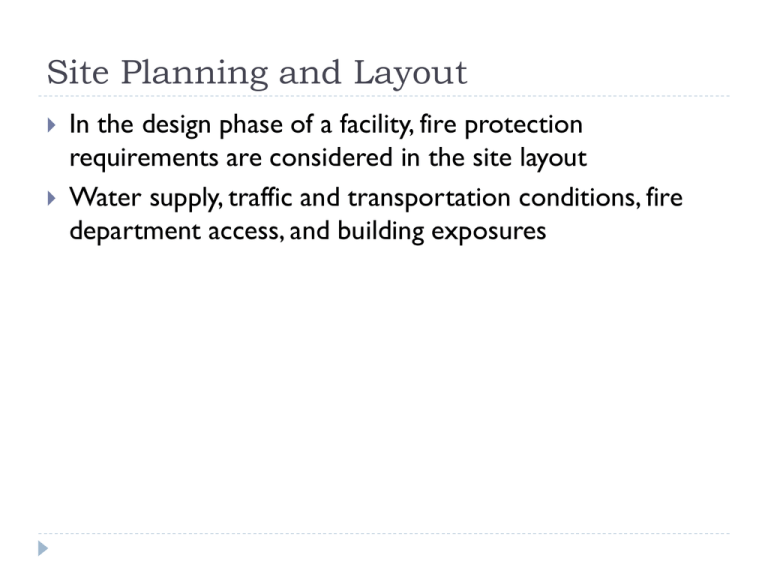
Site Planning and Layout In the design phase of a facility, fire protection requirements are considered in the site layout Water supply, traffic and transportation conditions, fire department access, and building exposures Water Supply and Use Building designer should anticipate the needs of both the fire department and automatic extinguishing systems Provide an adequate supply of water at an adequate residual pressure. Cities may not be able to supply a sufficient amount of water at required pressures to every part of the city May need to be boosted by pumps located on fire department apparatus or the buildings Water pressure for high rise buildings Traffic and Transportation Time Traffic conditions Access to buildings Fire Department Access Exterior accessibility - fire department apparatus from all sides Exposure From Other Buildings External fire hazards to neighboring structures Radiation and convection Factors Influencing Severity of Exposure Exposing Fire Temperature and duration Type of construction of exterior walls and roofs Width of exposing fire Height of exposing fire Percent of openings in exposing wall area Exposed Building Type of construction of exterior walls and roofs Orientation and surface area of exposed exterior walls Percent of openings in exterior wall area Protection of openings Exposure Protection Reference on Exposure Protection: NFPA 80A, Recommended Practice for Protection of Buildings from Exterior Fire Exposures NFPA 80A: Recommended Practice for the Protection of Buildings from Exterior Fire Exposures Provide a reasonable level of protection for combustibles within and on the exterior of a building exposed to external building fire Two major exposure sources: Exposure to radiation Radiant energy passing through windows or other openings Flames from burning building windows Flames from the burning façade Exposure to Flames Flames from the roof or top a building when the exposed building is higher than the burning building Minimum Separation Distances Calculated using a number of factors Width of the exposing fire Height of the exposing fire Exposure Severity Average combustible load per unit of floor area Characteristics and average flame spread ratings of interior wall and ceiling finishes. Using the larger of the height to width or width to height ratio of the exposing fire, the exposure severity, and exposure guide number, the minimum separation distance can be calculated using table values and multipliers. Means of Protection Various means of protection can be used to adjust the calculated separation distances downward Examples of protection measures include: Use of automatic sprinklers Use blank walls made of non-combustible construction Extend exterior walls Eliminate wall openings Use glass block panels in openings Building Electrical Systems As part of the building design, consideration must be taken with regards to electrical systems and equipment Number of structure fires per year due to electrical equipment: Electrical Distribution Equipment: 40,350 Appliance or Tool: 11,110 Heating Equipment: 5,830 Cooking Equipment: 5,210 Air-Conditioning or Refrigeration Equipment: 3,890 Sources for Fires Human Errors That Contribute to Fires Lack of Maintenance Improper Use Carelessness or Oversight Electrical Arcing Electrical Heating Electrical Safeguards Grounding Guarding Over current Protection Ground Fault Circuit Interrupters NEC Hazard Classifications Class I: Flammable Gases & Vapors Class II: Combustible Dusts Division 1 Division 2 Division 1 Division 2 Class III: Ignitable Fibers Division 1 Division 2 Hazard Classifications How are the hazard classifications used in industry? How do “explosion proof wiring and electrical components work? How would I select electrical equipment that is planned for use in a hazardous location? Codes and Standards NFPA 70: National Electrical Code OSHA Standards State and local electrical safety/building codes Chicago Electrical Code Alaska Electrical Code ANSI/IEEE: National Electrical Safety Code U.S. electrical industry and communications utility field National Electrical Code Format Chapter 1 General Chapter 2 Wiring and Protection Articles 200 – 299 Chapter 3 Wiring Methods Article 100 — Definitions Article 110 — Requirements for Electrical Installations Articles 300 – 399 Chapter 4 Equipment for General Use Articles 400 – 499 Chapter 5 Special Occupancies Chapter 6 Special Equipment Articles 700 – 799 Chapter 8 Communications Systems Articles 600 – 699 Chapter 7 Special Conditions Articles 500 – 599 Articles 800 – 899 Chapter 9 Tables OSHA Electrical Safety Standards 1910 Subpart S: Electrical 1910.301 - Introduction. 1910.302 - Electric utilization systems. 1910.303 - General. 1910.304 - Wiring design and protection. 1910.305 - Wiring methods, components, and equipment for general use. 1910.306 - Specific purpose equipment and installations. 1910.307 - Hazardous (classified) locations. 1910.308 - Special systems. 1910.399 - Definitions applicable to this subpart. Subpart S Appendix A Reference Documents OSHA Electrical Standards 1910.302(a) Scope OSHA standards under Subpart S cover electrical installations and utilization equipment installed or used within or on buildings, structures, and other premises, including: Yards; Carnivals; Parking and other lots; Mobile homes; Recreational vehicles; Industrial substations; Conductors that connect the installations to a supply of electricity; and Other outside conductors on the premises. OSHA Electrical Standards 1910.302(b) Extent of application Certain standards apply to certain applications based upon when they were designed and/or installed Globally Harmonized System of Classification and Labeling of Chemicals (GHS) Developed by the United Nations, the premise of the GHS is that existing chemical classification and labeling systems (such as OSHA’s Hazard Communication Standard (HCS)) “should be harmonized in order to develop a single, globally harmonized system to address classification of chemicals, labels and safety data sheets.” Covers all hazardous chemical substances, dilute solutions, and mixtures. The GHS is not a global law or regulation; it is a system or a set of recommendations. Flammable liquids Category 1: Extremely flammable liquid and vapour Category 2: Highly flammable liquid and vapour Category 3: Flammable liquid and vapour Category 4: Combustible liquid OSHA’s Flammable Liquids Definitions Under GHS Flammable liquid means any liquid having a flashpoint at or below 199.4 °F (93 °C). Flammable liquids are divided into four categories as follows: Category 1 shall include liquids having flashpoints below 73.4 °F (23 °C) and having a boiling point at or below 95 °F (35 °C). Category 2 shall include liquids having flashpoints below 73.4 °F (23 °C) and having a boiling point above 95 °F (35 °C). Category 3 shall include liquids having flashpoints at or above 73.4 °F (23 °C) and at or below 140 °F (60 °C). When a Category 3 liquid with a flashpoint at or above 100 °F (37.8 °C) is heated for use to within 30 °F (16.7 °C) of its flashpoint, it shall be handled in accordance with the requirements for a Category 3 liquid with a flashpoint below 100 °F (37.8 °C). Category 4 shall include liquids having flashpoints above 140 °F (60 °C) and at or below 199.4 °F (93 °C). When a Category 4 flammable liquid is heated for use to within 30 °F (16.7 °C) of its flashpoint, it shall be handled in accordance with the requirements for a Category 3 liquid with a flashpoint at or above 100 °F (37.8 °C). When liquid with a flashpoint greater than 199.4 °F (93 °C) is heated for use to within 30 °F (16.7 °C) of its flashpoint, it shall be handled in accordance with the requirements for a Category 4 flammable liquid. Classification Criteria Health and Environmental Hazards Physical Hazards Mixtures Hazard Communication Labels Safety Data Sheets Acute Toxicity Skin Corrosion/Irritation Serious Eye Damage/Eye Irritation Respiratory or Skin Sensitization Germ Cell Mutagenicity Carcinogenicity Reproductive Toxicity Target Organ Systemic Toxicity – Single and Repeated Dose Hazardous to the Aquatic Environment Physical Hazards Explosives Flammability – gases, aerosols, liquids, solids Oxidizers – liquid, solid, gases Self-Reactive Pyrophoric – liquids, solids Self-Heating Organic Peroxides Corrosive to Metals Gases Under Pressure Water-Activated Flammable Gases
